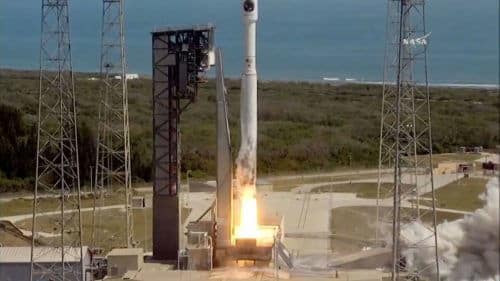Minister Akunis: Israeli pride of the future generation and increasing public awareness of the field of space

After several weeks of postponement due to fear of a malfunction in the launcher, the tiny Israeli student satellite "Dukhipat 2" was successfully launched into space today from Cape Canaveral in the USA. The satellite, a venture of The Israel Space Agency at the Ministry of Science and the Municipality of Herzliya, launched at exactly 18:10 aboard the "Atlas-5" launcher to the International Space Station. The satellite was launched with a swarm of 28 tiny satellites from around the world with the aim of mapping the thermosphere, a mapping that will help, among other things, in the transmission of GPS signals. Dokifat 2 is the only student satellite launched in this project, while the other satellites were built by students and researchers from around the world.
In about two days the satellite will arrive at the International Space Station, where it will be transferred to the Japanese part of the station, and in about a month and a half it will be sent into space using a special robotic arm operated by the astronauts and will begin to operate. The exciting launch was closely witnessed today by a delegation of about 14 students from Hora and Herzliya and the director of the Herzliya Science Center Dr. Meir Ariel. The students were accompanied by Bob Cabana, the director of NASA's Kennedy Space Center who served as the director of operations at NASA during the Columbia shuttle disaster in 2003 with Ilan Ramon on board.
According to the Minister of Science Ofir Akunis, "Dokifat 2 is not only an educational project that brings space closer to teenagers and paves the way for tomorrow's generation, but also an international research project. This is Israeli pride for the future generation and an opportunity to increase public awareness of the field of space."
The type of launcher on which Dokifat 2 was launched today is considered old and reliable and has so far been launched more than 30 times into space. The launcher was used, among other things, for famous missions such as launching a research probe to Mars, the New Horizons probe and the Juno probe to explore the planet Jupiter. In addition to the swarm of tiny satellites, with a total weight of 83 kg, the launcher also had a cargo spacecraft carrying 3,380 kg of research equipment and supplies to the International Space Station.
Dokifat 2 is the second tiny satellite developed by Israeli students and weighs only 1.8 kg. Dokifat 1 developed by students from the Herzliya Science Center was launched in June 2014 and is still active in space, beyond the original estimate. The current satellite was launched into space as part of the European Union's QB50 project with satellites built by students from Belgium, Turkey, South Africa, Australia, Germany, France, South Korea and more. Of the 50 groups from around the world that started working on satellites, only 28 passed NASA's rigorous tests, including the Israeli group.
More than 80 students - from Ofefkim, Mirocham, Maofra, Mehura (the Bedouin diaspora) and Herzliya - have been working for the past two years on the development of Dokifat 2. The students worked in ten teams and had access to a clean room, an electronics laboratory and a ground station for communication with satellites. Each team was responsible for a different area such as examining the technical specifications, programming the operating system, deciphering the satellite data, control, system engineering and more.
The students were accompanied by engineers from the academy and from the Bat Halal factory in the aerospace industry. The satellite successfully passed the tests carried out in the clean room at the Space Factory of the Aerospace Industry.
The data received from the satellite will be transferred to the ground station at the Herzliya Science Center, where the students will decode them. A year later, the satellites are expected to fly down, heat up and disintegrate in the atmosphere at an altitude of 90 km above the earth's surface.
Mayor of Herzliya Moshe Padlon He said "The Dokifat 1 and Dokifat 2 projects and the launch today are a tremendous achievement by any measure and testify both to the success of our high municipal investment in education in general and scientific education in particular, and to the high level of the youth in Herzliya. I have no doubt that by doing so we are contributing to the advancement of the technological and scientific future of the country."
See more on the subject on the science website:
- The children overcame all the obstacles that were on the way in the development of the Dokifat 2 satellite
- "We built a training system in which the graduates train the young people entering the Dokifat 2 project"
- Not a single screw in the Dokifat 2 satellite was screwed in by an adult, and not a single line of code was written by an adult
- Exclusive to the science website: first exposure of the student satellite Dokifat 2
